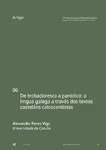De trobadoresca a paródica: a lingua galega a través dos textos casteláns catrocentistas

Ver/
Use este enlace para citar
http://hdl.handle.net/2183/32654
A non ser que se indique outra cousa, a licenza do ítem descríbese como Atribución-CompartirIgual 4.0 Internacional (CC BY-SA 4.0)
Coleccións
Metadatos
Mostrar o rexistro completo do ítemTítulo
De trobadoresca a paródica: a lingua galega a través dos textos casteláns catrocentistasAutor(es)
Data
2022-12-27Cita bibliográfica
Peres Vigo, A. (2022). De trobadoresca a paródica: a lingua galega a través dos textos casteláns catrocentistas. Revista Galega de Filoloxía, 23, 93-108. https://doi.org/10.17979/rgf.2022.23.0.9130
Resumo
[Resumo] Coincidindo coa consolidación dos Trastámara no trono castelán (1369-1388), a lírica galega enfrontou un período de decadencia a través da chamada escola galego-castelá. Con todo, as referencias directas ao galego, como signo identificativo do reino da Galiza e dos seus habitantes, non deixaron de se acrecentar na literatura castelá catrocentista. Entre elas, sitúanse textos breves da segunda metade do século XV, tales como dialoxismos e sentenzas estereotipadas, en que se reproduce a lingua galega cunha auréola xocosa. A súa aparencia híbrida, así como a propia finalidade burlesca dos textos, permítenos identificar estas aparicións como os primeiros experimentos literarios onde o galego xa é obxecto de parodia e onde se manifesta a existencia de prexuízos lingüísticos antigalegos. Un recurso literario que se consolidará no século XVI e que se popularizará, especialmente no XVII, da man dos vilancicos casteláns de temática galega. [Abstract] At the time of the Trastámaras’ strengthening of their hold in the Castilian throne (1369-1388), Galician lyrical poetry went through a period of decline, with the so-called Galician-Castilian school. Nevertheless, direct references to the Galician language as a distinctive sign of the kingdom of Galicia and its inhabitants kept increasing in number in Castilian literature from the 1400’s. Among them we find short texts from the second half of the 15th century, such as dialogisms and stereotypical sayings, where the Galician language is presented under a facetious light. This hybrid presentation, as well as the mocking purpose of the texts itself, allow us to identify these instances as the first literary experiments where the Galician language is already the object of parody and where the existence of anti-Galician linguistic prejudice is revealed. This is a literary phenomenon that will become consolidated during the 16th century and grow popular particularly in the 17th through Castilian villancicos containing anti-Galician themes.
Palabras chave
Lingua galega
Prexuízos lingüísticos
Século XV
Literatura española
Galician language
Linguistic prejudices
15th century
Spanish literature
Prexuízos lingüísticos
Século XV
Literatura española
Galician language
Linguistic prejudices
15th century
Spanish literature
Dereitos
Atribución-CompartirIgual 4.0 Internacional (CC BY-SA 4.0)






